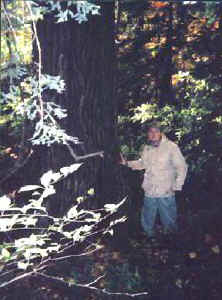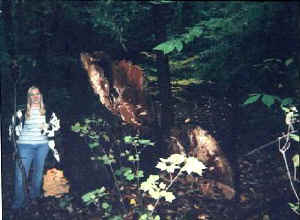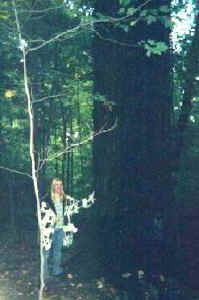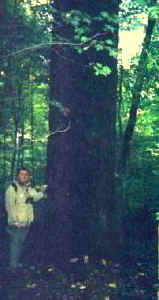Ents,
This message was originally an email sent privately to Dale
Luthringer a little over two weeks ago on Wednesday, November
16, 2005. He suggested that I post it to the ENTS discussion
list, so here it is:

13' 5" cbh red oak |
|
Dale,
I looked over the tree data in your last email. Yes, you'll
definitely want to get back to McConnells Mill again sometime. I
don't know how much you ENTS folks know about the place, but I
get the idea, since I've seen nothing about it on either the
ENTS website or in any of the old-growth books, that not many
folks are aware of what's there.
I'm guessing that when you mention "the rock outcrop where
the rock climbers go" you mean the one along Rim Road on
top of the gorge above the dam. (I think there is at least one
other rock climbing area.) I've looked at that area too. There
are some nice trees there. I found a white ash just up Rim Road
from there with 10'4"CBH. It looked pretty tall, but I
still don't have a laser or clinometer, so I can't say how tall
(yet). You probably saw a big red oak that's right beside the
road near the climbing area. Some of its lower limbs have been
trimmed off over the years so that cars could pass. I measured
it's CBH at 12.5'. That includes a lot of root flair, though.
Another easily accessible tree is one of the biggest I've found
at mcconnells Mill. It is right up the (pretty steep) hill
behind the toilets that are near the old mill itself. It is a
very large and tall red oak. CBH = 13'5".
My biggest thrills came when I discovered what I you described
as the "big woods section." For now, forgive me for
being long-winded, but I'll tell you in detail about what I
found on my five trips to this area.
On Sunday (Oct 2) I drove up to mcconnells Mill and parked
along a road to the North of the park. Maps, satellite photos,
and compass in hand I started into the woods heading in the
direction of the gorge. I walked about fifteen or twenty minutes
through old-fields that have been growing back into forest for
about 40 years or so. I crossed an old row of piled field stones
and soon realized that I was surrounded by huge old trees! At
first there were a few large red oaks, then eventually tulip
poplars, cucumber magnolias, and American beaches. I kept
walking south and west and the big trees just kept coming!
What amazed me was that I was still traveling on relatively
flat, accessible land with no sign of the gorge in sight. From
everything we know about why remaining bits of old growth still
exist, there is no obvious reason why these trees should still
be there. They are not down in the gorge or otherwise in an
inaccessible spot. They should have met with the saw ages ago,
but there they were!

Fallen Oak 12' 2" cbh |
I followed
an old path for about another 1/4 to 1/2 mile before coming to
the gorge, still surrounded by big oaks, tulips, cucumbers, and
beaches. Along the way I had stopped to measure one big oak
(black, I think) that had recently fallen. It
measured 12'2" CBH. I didn't try to measure its height, but
it didn't seem to be remarkably tall. [Iíve since measured its
length. It would have been about 110í+ tall.]
I don't want to give the impression that every other tree there
is a giant. I'd be walking along seeing mostly
"normal" sized trees, and then suddenly another large
old one would appear before me.
I kept following the path until it reached the top of the gorge.
There the path forked. The left fork went north, upstream, and
down into the gorge itself. The right fork went south-west,
downstream, and continued along the top of the gorge. I took the
right fork. It followed the gorge for about a quarter of a mile
or so then headed back uphill northwards. I stopped here and
there to measure trees along the way. I continued along the
trail for another 1/4 or 1/2 mile (now going north) before I
turned around and headed back. Big trees were still popping up
here and there in all directions, not a stump in sight.
I returned to the fork in the trail at the top of the gorge and
then took the path on the left end of the fork. It descended
along what must have been an old, narrow road down into the
steep gorge. It ended up at the bottom coming out to Slippery
Rock Creek. Here the trail intersected with the Slippery Rock
Gorge Trail. This was right at the place called Walnut Flats. I
walked around this low flat area quite a bit. I only found two
walnut trees. One walnut, located just where the trail comes off
the gorge's steep slopes and onto the flats, looked to be
ancient. It measured 10'3" CBH, showed quite a bit of
balding, and had thick moss growing far up its trunk. The other
was not particularly large it measured 7'9".
Here on Walnut Flats I found no big trees like I'd seen on the
flat area up on top of the gorge. I was disappointed. From my
previous study of the topographic maps of the area, I expected
this to be the best area. It is basically a piece of flat bottom
land surround by steep canyon walls.
Hanging out over the creek, though, there was an old sugar maple
(CBH 9'1") with thick moss running about 20 feet up its
trunk. Across the creek through my binoculars I
could see a very large tulip poplar. This tree, unlike a lot of
the trees I'd seen earlier, appeared to be tall. I had no way to
get across the creek to get a better look, though. These two
trees are right along the slippery Rock Creek trail. I'd seen
both before on one of my first hikes through the gorge this past
summer. I believe that I mentioned them to you already.
By then it was getting to be time to call it a day, so I headed
back up the path to the top of the gorge and then on northwards
towards the road. As I was coming out to the old stone row at
the edge of the old-growth, I looked westward and saw down in
the woods what appeared to be a rather large red oak. I couldn't
really tell how large it was as I was a good distance away from
it.

13' 9" cbh Red Oak |

13' 9" cbh Red Oak |
As I
approached, it just kept looking bigger and bigger until I
realized as I came right up to it that it was by far the biggest
tree I'd seen all day. It was just plain huge! It measured
13'9"CBH. Its trunk goes about 25ft straight up and then
starts to branch. It is on flat relatively flat ground and
appears to be in fine health. It is, of course, no champion, but
is still, nonetheless, an absolutely incredible tree! I am still
new to his and not good at estimating heights, but I would
probably guess that it is only about 80 or so feet tall.
What I have just described above was only my first day in that
area of the park on October 2. Since then, I've gone back to it
four times and have spent a good fifteen to twenty hours
exploring the old growth there. I still can't say yet that I've
seen all of it!
And I'm just talking about this one flat area on top of the
gorge and to its north. I noticed from a previous trip in
September that there is old-growth scattered through pretty much
the entire length of the gorge itself! I haven't yet discovered
anything as quite spectacular as what I've found on top, though.
Of course, there is still a good bit of the gorge that I haven't
been to yet.
On my four subsequent trips I tried to get a general outline of
that upper area of the park and the park's borders. I've also
tried to delineate the perimeter of the old-growth area on top,
the "big woods section" as you called it. I've been
able to find the eastern and northern boundaries of the
old-growth.
Along its eastern end there is a property line and suddenly a
patch of old stumps and only younger trees, marking what appears
to be a 60 plus year-old clear-cut. The northern boundary is
along the old row of field stones that I mentioned earlier.
To the west it's more complicated. Along the north-western
corner there is a ravine that only has young, even-aged trees on
its top north-western side, but as you head downhill and south
from the top and towards the gorge you encounter big trees
again. Like I said before, though, it's not like every other
tree is huge. Big trees just pop up here and there. They
continue on along the top of the gorge south and westward for at
least another half mile until the top of the gorge meets with
another smaller gorge formed by a tributary stream. Here old
stumps suddenly come right up to the smaller gorge.
I made it this far on my last trip to MMSP just this last
Saturday. I had to turn back when I got to this point because it
was getting late in the day, so I didn't get to go up and around
the smaller gorge to see if the old growth continued on it's
other side. I doubt that it does, though. I most likely crossed
an old property line when I encountered the stumps. This smaller
gorge also marks the present property line of the park itself. I
don't know when I will be able to get back to this area to
actually find out.
I did some zigzagging off the trail and down in from the
perimeter of big tree area on top of the gorge during my five
trips there, I would guess that I have only seen about 60% of
the inside of this area, though. I hope to systematically
explore the whole area in my next few excursions there.
Hopefully, I'll run across a few more big ones. I've learned
that this whole area is about 75 acres.
Below is a list of the trees that I have discovered and measured
so far. I've only been able to measure CBH's because, like I
said, I still don't have either a clinometer or a laser range
finder. (I've taken some pictures, too. Most came out dark, but
I'll show them to you when I see you.)
None these trees are champions, but they are old, large, and
impressive, nonetheless. Most of them do not appear to be
exceptionally tall. Perhaps this is because the ground on which
they are growing is very rocky. Just under the nice dark top
soil is mostly 12"-20" sized boulders.
Here is a list of some trees and their CBH's:
Tree CBH
Am Beach 8'10"
Am Beach 9'0"
Am Beach 9'0"
Am Beach 9'3"
Am Beach 9'3"
Am Beach 9'6"
Black Gum 6'6"
Black Gum 7'0"
Black Oak (fallen)
12'2"
Black Walnut 7'9"
Black Walnut 10'3"
Chestnut Oak 7'8"
Chestnut Oak 8'6"
Cucumber 9'10"
Cucumber 9'11"
Cucumber 10'4"
Red Oak 10'4"
Red Oak 11'2"
Red Oak 12'4"
Red Oak 12'6"
Red Oak 12'10"
Red Oak 12'10"
Red Oak 13'3"
Red Oak 13'9"
Sugar Maple 9'1"
Tulip 10'8"
Tulip 10'8"
Tulip 10'11"
Tulip 11'0"
Tulip 11'2"
Tulip 11'2"
Tulip 11'3"
Tulip 11'5"
Tulip 11'11"
White Ash 10'11"
White Oak 13'1"
The whole area, and the gorge itself I find to be just amazing.
Maybe I am still too new to this and have been overly impressed,
but I think that some of the other ENTS people should give this
place a look if they haven't already. Have they explored already
explored the park? What have you already heard about the top
flat area?
I hope that this email wasnít too long.
Tony
|